|
 
COVER
STORY | GOOD
NEWS | GARDEN | EDITORIAL | CALENDAR
July 24, 2003
Sam Swanlund, longtime photographer, is dead at
72
by BOB
DORAN
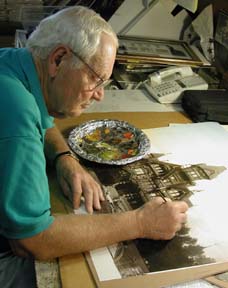 Humboldt
County photographer and businessman Sam Swanlund died July 18
at his home on Pigeon Point Road, the apparent victim of a heart
attack. He was 72. Humboldt
County photographer and businessman Sam Swanlund died July 18
at his home on Pigeon Point Road, the apparent victim of a heart
attack. He was 72.
Swanlund, who ran a photo shop
in Eureka for years, was known for colorizing black-and-white
historical photographs through detailed painting.
Born in Eureka in 1931, Swanlund
lived in Humboldt County his entire life apart from a couple
of years as a student at the University of California at Santa
Barbara, and a stint with the U.S. Army as a cryptographer during
the Korean War. He loved to travel, however, and Mexico was a
favorite destination; he undertook a solo journey there in his
late teens and returned frequently with his wife, the former
Wanda Wilson.
In 1958 he took over Swanlund
Camera, a photo finishing and photographic supply store founded
by his father, Oscar Swanlund. He ran the business for 31 years,
selling it in 1989.
Not willing to sit idle in retirement,
Sam went back to work shooting photos and doing public relations
for Louisiana Pacific Lumber Co. He taught photography classes
at College of the Redwoods and through Eureka Adult Education
and Humboldt State University Extended Education. He also kept
busy doing work for the Seventh Day Adventist Church and offering
"community comment" on KINS radio every other Wednesday.
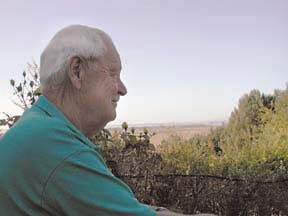 His
other passion was work he saw as his "legacy to the community,"
oversized historic photographs showing Humboldt County early
in the 20th century that he hand-colored in meticulous detail.
(See NCJ
cover story, "Working on his
legacy," Sept. 12, 2002.) His
other passion was work he saw as his "legacy to the community,"
oversized historic photographs showing Humboldt County early
in the 20th century that he hand-colored in meticulous detail.
(See NCJ
cover story, "Working on his
legacy," Sept. 12, 2002.)
Swanlund is survived by his
wife, Wanda, of Eureka; and five children, Richard Swanlund,
of Fortuna; Brenda Hayes, of Grants Pass, Ore.; Daron Wilson,
of Lincoln City, Ore.; Sandi Curran, of Grants Pass, Ore.; and
Scott Swanlund, stationed with the U.S. Air Force in Aviano,
Italy; 11 grandchildren; and five great-grandchildren.
A memorial service is scheduled
for noon on July 25, at the Seventh Day Adventist Church, 4251
F St., Eureka. The family requests that donations in Swanlund's
name be made to the Humboldt Area Foundation, or to the Humboldt
Bay Adventist Christian School. Both are located in Bayside.
Cherney
says he won't be a millionaire
But life should get easier
for Earth First activist
by
HELEN SANDERSON
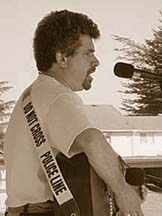 There's
money on the horizon -- about $1.5 million -- but until it arrives
Darryl Cherney's life is not likely to change. There's
money on the horizon -- about $1.5 million -- but until it arrives
Darryl Cherney's life is not likely to change.
The 47-year-old Earth First
activist known for his leadership during logging protests on
the North Coast in the late 1980s and early 1990s says he still
lives the life of a struggling environmentalist. He called his
dwelling outside Garberville a "shack" and said he
recently had to borrow money from his parents.
"I'm not going to be a
millionaire and I'm certainly not one now," Cherney said
after the Oakland City Council unanimously voted last week to
pay $2 million to Cherney and the heirs of Judi Bari.
The settlement offer, which
has yet to be approved by the court, comes almost a year after
a jury determined that the city of Oakland and the FBI violated
Cherney and Bari's civil rights when they accused them of illegally
transporting an explosive device after a bomb went off in Bari's
car in 1990.
The blast shattered the pelvis
of Bari, who was driving with Cherney through Oakland at the
time. Cherney was unhurt. Bari died of cancer in 1997.
The federal government has also
tentatively agreed to pay $2 million, bringing the total proposed
settlement to $4 million. That's $400,000 less than the jury
award, which called for giving Bari's heirs $2.9 million and
Cherney $1.5 million.
Cherney said he was skeptical
that the federal government would actually pay up. "I'm
not counting any FBI chickens before they hatch," Cherney
said. "I've been dealing with them for 13 years now, so
I'll believe it when the check clears."
Whatever final amounts are agreed
on -- in addition to the fact that the court has yet to approve
anything, the various sides are still negotiating -- half of
the money reserved for Bari's estate will go to her two daughters.
The other half will go to the Redwood Justice Fund, a legal fund
to help activists.
Cherney, meantime, expects that
much of his money will be used to pay debts. "Once [the
money] comes in, a large portion of it will go toward my lawyers
and income tax," Cherney said, who estimated that he'd probably
end up with no more than $500,000.
Cherney, who has lived in Southern
Humboldt for the past 17 years, said he plans to use the money
to publish a book on the history of the campaign to save the
Headwaters Forest, produce his four music albums, complete a
film about the 1990 bombing, donate to a number of non-profits
and possibly purchase property in Humboldt County.
In addition, Cherney says that
the money will help his commitment to activist work. With the
extra cash, the need for fund raising will be minimized, freeing
up more time to devote to environmental activism.
"Let's put it this way,"
Cherney said. "I won't be retiring any time soon."
Heck's
Angels
Bikers at last weekend's
Redwood Run festival were surprisingly well behaved
story and photos by MATT CRAWFORD
The main drag in Garberville
was packed with motorcycles last Friday, shiny machines manufactured
by Harley-Davidson. It was about 6 p.m. but the air was still
hot and filled with the endless drone of bikes cruising up and
down, loaded with supplies for the weekend's main event.
It was day one of the Redwood
Run and as I attempted to gather my own supplies for the two-day
party on the Eel River, I tried hard to avoid any collisions
with bikers weaving through the streets. I could visualize the
headlines in Sunday's paper:
Journalist beaten by motorcyclist
after collision at biker rally
After all, bikers don't have
the greatest reputation for constructive conflict resolution.
The hellish motorcycle riot that erupted at a run in Laughlin,
Nev., last year didn't ease my paranoia, nor did my recollection
of Hunter S. Thompson's book, Hell's Angels: A Strange and
Terrible Saga. And of course there's the infamous 1969 Altamont
concert, where Hell's Angels enforced security by beating people
with the fat end of pool cues (and in the process killed a black
man).
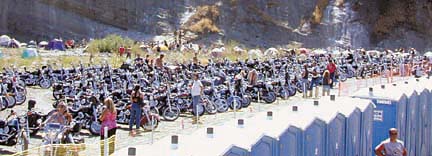 No
wonder that for decades, bikers (especially male Harley-Davidson
riders) have been typecast as rowdy characters that live life
with reckless abandon. Many of the riders have a fetish for leather,
chains and bikes that bark at ear-splitting levels. They like
tattoos, beer and they don't take no shit from no one. At least,
that's what I'd heard. No
wonder that for decades, bikers (especially male Harley-Davidson
riders) have been typecast as rowdy characters that live life
with reckless abandon. Many of the riders have a fetish for leather,
chains and bikes that bark at ear-splitting levels. They like
tattoos, beer and they don't take no shit from no one. At least,
that's what I'd heard.
Since the Redwood Run is strictly
limited to bikers who drive Harley-Davidson bikes and other American-made
motorcycles, it seemed like a good opportunity to get a glimpse
of the people who ride these icons of our culture.
For 26 years, motorcycle enthusiasts
from around the country have flocked to the Eel River to hang
out at the Run. This year, a crowd of nearly 5,000 people listened
to live music from Joan Jett and the Doobie Brothers, among others,
and participated in "biker games" that have become
a mainstay of the event. While there were no major races, there
was a loudest bike contest, not to mention a hot-dog eating competition.
A free steak dinner, a wet T-shirt contest (for the guys) and
wet shorts contest (for the girls) provided extra bonuses for
attendees.
On average, the crowd appeared
a little rougher than your typical weekend music festival. However,
after establishing a site at a campground near Piercy and meeting
some of the revelers, my perspective began to change.
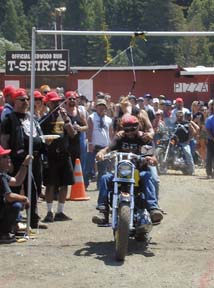 Immediately
after I exited my vehicle I was greeted with offers of beer and
other goodies from my neighbors. Somewhat surprised, I declined
and opted for a drink out of my cooler. Immediately
after I exited my vehicle I was greeted with offers of beer and
other goodies from my neighbors. Somewhat surprised, I declined
and opted for a drink out of my cooler.
Glad for some protection from
the late afternoon sun, I grabbed a piece of shade under a canopy
supplied by Wayne, an aging biker from Coos Bay, Ore., and his
two female companions, Maureen and Sharon. Wayne was soft-spoken
but with a hard-edge, probably from spending years on the road.
He had a taste for red wine, cognac and big, expensive Harleys.
His gold and chrome Sportster
cost $30,000 and he had four other show bikes back at home. When
he talked you could tell he had a love for the machines, even
if the automotive jargon that spewed out of his mouth was incomprehensible.
And it was clear that Wayne both rode and camped in style. He
was well stocked with alcohol, steaks and a full-size barbecue.
The larger scene was nothing
like what I had expected. With the exception of the continuous
roar of Harleys, the abundance of leather and denim clothing
and the absence of reggae music, the campground had a vibe very
similar to Reggae on the River, held just a few miles north of
the Run every August.
Food and drink were shared openly
and there were even a couple of folks sporting dreadlocks.
Perhaps I was in the wrong area.
Maybe the chunky brown stuff that my neighbor claimed was "the
best hash in Humboldt County" had sedated the bunch. Either
way, if there was any action, it was going on somewhere else.
Down in The Pit, the center
of the festival, the scene was a bit rowdier. Grizzled men in
leather, heavily made-up biker babes and weekend warriors in
shorts and sandals strolled around while the Gregg Rolie Band
performed. Harleys with elaborate parts and paint jobs were everywhere.
At the edge of one of the few
camping areas in The Pit, there was a large area with several
tents, a couple of benches, a couch and a stereo system with
a strobe light. Several of the bikers in the camp were members
of the Daly City Hells Angels. If there was going to be any trouble,
this could be the spot.
Fortunately, things remained
relatively calm, and by the next day I was ready to find out
what the Daly City club was all about.
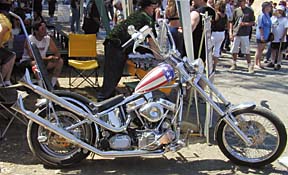 It
was early evening when I approached a large biker with a buzz
cut. He was sporting a black, sleeveless jacket with a "Hells
Angels" patch spanning his shoulder blades. Below it an
Angels "Deathhead" (a skull with wings that is trademarked
by the club) was sewed above the words "Daly City." It
was early evening when I approached a large biker with a buzz
cut. He was sporting a black, sleeveless jacket with a "Hells
Angels" patch spanning his shoulder blades. Below it an
Angels "Deathhead" (a skull with wings that is trademarked
by the club) was sewed above the words "Daly City."
I introduced myself and asked
the biker an admittedly dumb question: Was he with the Hells
Angels?
He nodded.
"I'm writing an article
about the Run, can I ask you a few questions?"
He shook his head with disapproval.
I got the point and strolled down the road.
Ten minutes later, I was returning
to the stage when I encountered another Angel, who appeared to
be in his mid-20s. He was wearing an identical jacket and his
response was the same.
"Naw, I got nothing to
say," he replied.
Apparently the Daly City Angelss
don't like the media or anyone else who gets too curious about
the club's business. That's made clear in the club's website:
"It's a private club and any private club doesn't discuss
things such as number of members, who the members are, etc.,"
the website states.
Regardless of why the Hell's
Angels I approached wouldn't talk, I wasn't willing to hang around
their encampment to find out how they dealt with unwanted visitors.
Nonetheless, after two days of not seeing a single fight or yelling
match with the Angels or any other audience members, it appeared
that everyone I encountered at the Run was there for the same
reason -- to let loose and have a good time.
Perhaps a middle-aged biker
who was waiting in line for the shuttle to The Pit said it best:
"It's hard not to have fun at the Redwood Run."
The former special projects
editor at The Lumberjack, Matt
Crawford is a freelance writer and a part-time dishwasher. His
work appears regularly in local newspapers.
Photos: top, Bikers parked
along the Eel River. Middle, Bikers participate in the hot dog
eating contest. Last, Easy Rider replica motorcycle.
Journalism
flap
At a time when the integrity
of journalists is under fire,
a controversy involving the Arcata Eye surfaces
by
KEITH EASTHOUSE
It's a murky tale, but a few
things are clear.
A $1,000 check arrived at the
offices of the Arcata Eye made out to freelance reporter
Hank Sims. Its purpose was to fund an investigation into a potential
conflict of interest involving Humboldt County Supervisor Roger
Rodoni. Sims, by all accounts, tore up the check; he knew that
accepting third-party payment was a no-no as it smacked of buying
journalism. He went ahead and did the piece, and then received
a modest payment from the Eye.
End of story? Not quite.
Daniel Mintz, who until recently
wrote for the Eye, was disturbed when he learned about
the episode.
He felt that the article Sims
wrote, which revealed that Rodoni pays his landlord, the Pacific
Lumber Co., a mere $350 a month in rent for a three-bedroom home
on a 9,000-acre ranch, was fair and accurate.
But he thought another investigative
story was needed about how the check came to arrive at the Eye
in the first place. Why? Because a prominent Rodoni critic,
Arcata Mayor Bob Ornelas, acted as a middle-man between the check
writer, a Eureka woman named Linda Wright, and the newspaper.
"I was bothered by Ornelas'
undue editorial influence," Mintz said last week.
Mintz said he was also bothered
by "a lack of editorial oversight" by Arcata Eye
Editor Kevin Hoover. How did things get so far along that
a check was actually made out to Sims and sent? Mintz wondered.
When Hoover decided not to authorize the follow-up story Mintz
was proposing -- since Sims had not taken the money he didn't
see what the issue was -- Mintz quit in protest.
When word about all of this
got out, Rodoni claimed that the Eye had done a "hit
piece" on him, although he has yet to identify any inaccuracies
in the story.
Neither Sims nor Hoover would
identify Ornelas as the person who communicated the information
that someone in the community was willing to pay $1,000 for a
story on Rodoni. However, in an interview earlier this week,
Ornelas himself said he had played that role.
He said Wright contacted him
after Ornelas had publicly questioned the legality of Rodoni
voting against District Attorney Paul Gallegos' request in March
for outside legal assistance in his fraud lawsuit against the
Pacific Lumber Co.
"She had been very offended"
by Rodoni's conduct at a previous public meeting, Ornelas said,
and "wanted to know how she could help out." How that
desire got translated into an offer of money is not clear.
What is known is that Ornelas,
who had unsuccessfully tried to persuade the Arcata City Council
to pass a resolution condemning Rodoni, eventually approached
Hoover and let it be known that funds were available.
Far from feeling he did anything
wrong, Ornelas said that he was merely responding to the large
number of his constituents who had complained to him about Rodoni.
"I was just doing my job as a public servant," Ornelas
said.
But, given the controversy that
has erupted, Ornelas said that if he had to do it over again
he would simply have urged Hoover to do a story and not mentioned
anything about money.
As for Hoover, it is not clear
whether he was initially amenable to Ornelas' overture, but he
evidently didn't tell the mayor no. "I wasn't aware of all
the wrinkles as I am now with regard to this sort of thing,"
Hoover said last week. "Most ethical things are simple.
This one was quite complex."
There's some truth to that.
While it's a somewhat controversial practice, third parties do
at times fund investigative journalism. Maclyn McClary, a journalism
professor at Humboldt State who teaches a news media ethics course,
pointed to the Pew Charitable Trusts, a foundation that has shelled
out a lot of money to encourage better community reporting by
the media. "Some people object to that because they say
newspapers ought to pay for investigative reporting," McClary
said, "but some [of the stories Pew has funded] have shed
some light on some important stories."
McClary said he didn't know
enough of the details of this particular situation to make a
judgment about whether anyone was guilty of any wrongdoing. But
he said there was a need to "connect the dots."
"Who knew about [the offer
of $1,000] and when did they know about it? And did it in any
way effect the reporting?" McClary asked.
Change
of leadership at KHSU
by BOB
DORAN
Terry Green, station manager
of Humboldt State University's radio station, KHSU-FM, announced
this week that he is leaving the position at the end of August
to become the general manager at KUSP, a National Public Radio
affiliate in Santa Cruz.
That development comes hard
on the heels of HSU President Rollin Richmond's appointment earlier
this month of Elizabeth Hans McCrone as the interim general manager
for KHSU. Hans McCrone had previously been the university's director
of community relations.
According to Hans McCrone, there
are no plans to replace Green. "What it does is, it leaves
open Terry's salary for a number of possibilities," she
said. Hans McCrone declined to quantify Green's salary. She said
she would be paid $77,500 a year in her new job.
McCrone said it is likely that
she will absorb most of Green's responsibilities. "It will
make my learning curve a bit steeper," she said. She emphasized
that Green applied for the job at KUSP several months ago, before
she was appointed to her position.
Green has been with KHSU for
nine years. Initially hired as chief engineer, he became assistant
station manager in 1996, and was appointed station manager by
HSU's former director of development, John Sterns, in 1999. Green's
tenure included a tumultuous period where the station suffered
the after-effects of management by Sterns, who diverted KHSU
funds and was convicted of embezzlement, falsifying records and
forgery.
Green had to mend fences after
Sterns prepared fraudulent financial statements for KHSU, signing
the name John King, a non-existent San Francisco accountant to
papers filed with the Corporation for Public Broadcasting.
"KHSU's ability to carry
out [its] mission of serving the community is severely hobbled
by our funding problems and the administrative wreckage around
us," wrote Green in a letter to the court when Sterns was
facing sentencing. The station had to lay off three of its seven
full-time employees in the wake of the scandal.
COVER
STORY | GOOD NEWS | GARDEN | EDITORIAL | CALENDAR
Comments?

© Copyright 2003, North Coast Journal,
Inc.
|


 Humboldt
County photographer and businessman Sam Swanlund died July 18
at his home on Pigeon Point Road, the apparent victim of a heart
attack. He was 72.
Humboldt
County photographer and businessman Sam Swanlund died July 18
at his home on Pigeon Point Road, the apparent victim of a heart
attack. He was 72. His
other passion was work he saw as his "legacy to the community,"
oversized historic photographs showing Humboldt County early
in the 20th century that he hand-colored in meticulous detail.
(See
His
other passion was work he saw as his "legacy to the community,"
oversized historic photographs showing Humboldt County early
in the 20th century that he hand-colored in meticulous detail.
(See  There's
money on the horizon -- about $1.5 million -- but until it arrives
Darryl Cherney's life is not likely to change.
There's
money on the horizon -- about $1.5 million -- but until it arrives
Darryl Cherney's life is not likely to change. No
wonder that for decades, bikers (especially male Harley-Davidson
riders) have been typecast as rowdy characters that live life
with reckless abandon. Many of the riders have a fetish for leather,
chains and bikes that bark at ear-splitting levels. They like
tattoos, beer and they don't take no shit from no one. At least,
that's what I'd heard.
No
wonder that for decades, bikers (especially male Harley-Davidson
riders) have been typecast as rowdy characters that live life
with reckless abandon. Many of the riders have a fetish for leather,
chains and bikes that bark at ear-splitting levels. They like
tattoos, beer and they don't take no shit from no one. At least,
that's what I'd heard. Immediately
after I exited my vehicle I was greeted with offers of beer and
other goodies from my neighbors. Somewhat surprised, I declined
and opted for a drink out of my cooler.
Immediately
after I exited my vehicle I was greeted with offers of beer and
other goodies from my neighbors. Somewhat surprised, I declined
and opted for a drink out of my cooler. It
was early evening when I approached a large biker with a buzz
cut. He was sporting a black, sleeveless jacket with a "Hells
Angels" patch spanning his shoulder blades. Below it an
Angels "Deathhead" (a skull with wings that is trademarked
by the club) was sewed above the words "Daly City."
It
was early evening when I approached a large biker with a buzz
cut. He was sporting a black, sleeveless jacket with a "Hells
Angels" patch spanning his shoulder blades. Below it an
Angels "Deathhead" (a skull with wings that is trademarked
by the club) was sewed above the words "Daly City."